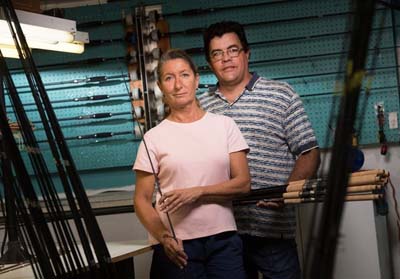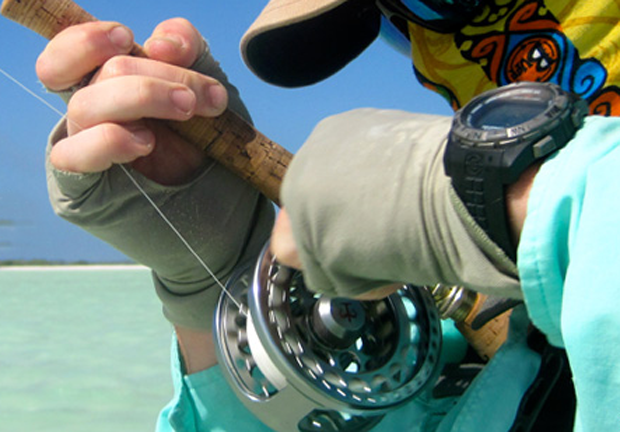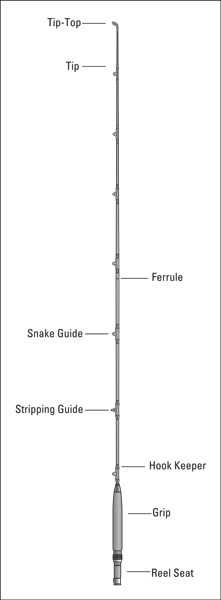
President Jimmy Carter with Bill Oyster. Oyster built Carter a bamboo fly rod. Carter, our best fly fisher president. Photo credit by Shannen Oyster.
A bamboo fly rod and the luck of the draw

Skip Clement, Publishing Fly Life Magazine.com Inc. for almost 20 years.
By Skip Clement
A steelhead was the first fish I caught on a fly rod and reel. I hooked three on that initiation day in the upper peninsula of Michigan. I landed one. They were all irritated into a strike near gravel beds. The flies were traditional trout and salmon flies. I cannot remember what the flies were called by name. Too many years ago, and I was then a beginner.
I recall the reel but not the rod. The latter was brand new and in a wooden case. It was made in Michigan by a craftsman whose name I can’t recall. The rod’s designations were the signature and three letters—HDH (a line designation of double taper 6-weight). The rod was two pieces and well under 9 feet. There were two extra tips. It was a hexagon and built with Tonkin cane.
The reel was a beautifully crafted Bogdan
I subsequently bought it for $100. All the other details long ago forgotten.
From that experience, I bought my own bamboo rod, built by a U.S. Steel (Homestead Works) millwright craftsman named Tony Morselli. Tony and I became good friends and fished Pennsylvania’s vast riverine stretches for years.
The bamboo rod was probably the equivalent of today’s graphite 6/7-weight and 8-feet. It cost $550. In the five years I fished it, it only required one repair. It was stolen from my car in Cedar Creek, Pennsylvania, probably for the Bogdan reel that caught the Michigan steelies.
Casting a bamboo fly rod
Not a cheap one from the Orient or a vintage collectible, but one currently built by a craftsman here in the U.S. or Canada. Someone who probably cut his teeth on graphite would be a good go-to person. They would know, from that graphite experience, what a fly angler wants in rod performance. And I have yet to talk to a cane rod builder who doesn’t avidly fish.
Is bamboo different from fiberglass?
Yes and no. Yes, it feels different. No, it’s not an underachiever in distance, accuracy, or lifting. The best way to introduce yourself to a bamboo rod is to first cast comfortably short with the least amount of personal power applied to make that distance. Cast several times at that distance so you feel the rod working, not you. Then, increase the distance in small increments with multiple casts at each distance. You’ve got to feel the line load the rod and slow down.
Hint
Overpowering the rod is almost 100% of the gone-wrong casting with bamboo. Bamboo wants to work for you. It’s like a sheepdog – let it work.
Back to the Future
Today, there are more kinds of bamboo rods than any other rod. Bamboo and fiberglass get a lot of coverage this day, with the word ‘resurgence’ found in every hot-off-the-press article about them. Bamboo never went away, nor did fiberglass, but there is no question that interest is resurgent in both.

Inimitable Lefty Kreh, the father of modern day fly fishing said that it’s hard to find a bad fly rod these days [paraphrased]. Clement Photo.
Jumping ship
My second fly rod type was born out of the 40s: fiberglass. By the time I switched to it, fiberglass technology was nearly at its peak of capabilities. Three came into my possession. A 5-weight, an 8-weight, and a 10-weight. Tony Morselli built all three of those rods that caught several fish while traveling the world: trouts, Pacific and Atlantic salmon, sailfish, peacock bass, smallmouth bass, roosterfish, bonito, dolphinfish, sharks, tarpon, snook, bonefish, and a myriad of other species.
Their fate: one never made it home for Columbia—a luggage loss; one was chewed by my beagle puppy, and one I gave to an employee. I was moving on.
Graphite time
Although graphite was introduced in the 1960s, I switched to it in the 1970s. Graphite rods were lighter and faster-acting fly rods than my fiberglass rods. So-called improvements came with the territory of graphite, almost always in the names of lighter, faster, and stronger—and that boast continues today.
Then, the Redington phenomenon of the 90s swept the sleepy world of rod building like Katrina. It was a lifetime guarantee introduced by Orvis, an iconic company whose impact on the fly fishing scene had waned. The guarantee shook up the landscape.
The phenomena of a book and movie
In 1992, the movie A River Runs Through It started a fly-fishing stampede, and interest in its beauty grew the fumble-prone fly-fishing industry faster than bacteria. Orvis’ guarantee was serendipitously timely, and it was a serious bid to get back in the ‘bigs.’

Above, Margot and Dave Redington of Stuart, Florida. They were the design and manufacturing component of the phenom of Redington Rods. Jim Murphy was the business end of Redington Rods.
Three people
The inimitable Jim Murphy, workhorse Dave Redington, and his wife Margo, all from Stuart, Florida, entered the fly rod market with a good, inexpensive fly rod with a lifetime guarantee. Redington Fly Rods exploded on the market.
The movie, lifetime guarantee, and Redington Rod’s factors flipped the industry on its head. From it came more intelligent management, marketing, better service (which had been horrible), better fly rods and higher, and now astronomical pricing.

Jim Murphy.
Yes, you’re now paying 100s of dollars for that guarantee
The other thing that pervasively persists today is each year’s new fly rod model, which has been the greatest thing since sliced bread. The better-than-sliced-bread model of two years ago is barely mentioned. Truthfully, good casting fly rods are not hard to come by today – Lefty Kreh said.
But it still all boils down to how well you cast and how accurate you are.
About fly rod weights
Today’s rod weights range from 1 pound to 15-pound. The most sold weights are 4-pound through 10-pound. The rod sold the most to trout folks is the 5-pound, and for salty folks, it’s a toss-up annually between an 8-pound and a 9-pound.
Modern graphite fly rods can throw more than one line class. For example, a good 7-weight can throw a 6-weight, 7-weight, or 8-weight fly line.
Most single handed fly rods are from 7-feet to just a bit more than 9-feet. When they reach 10-feet in length, they can be switch cast with an extended butt and move into a different class – two handed rods. However, most switch rods can straddle both worlds because they can be overhand cast and swung like a Spey rod.

Adult steelhead trout – illustration provided courtesy of Thom Glace.
Performance
When fly rod builders talk about casting performance, they describe action – a measurement of two factors. One, how much and where the rod bends when the flying fully loads the rod. Two, how fast does the rod recover from that bend?
Taper and placement of the guides impact a rod’s action. Fast action rods bend to about 30% (+/-) of their length when loaded; medium action rods about 60% (+/-), and a slow action fly rod up to about 90% (+/-).
Federation of Fly Fishers (FFF) casting instructors, professional guides, and tournament-level anglers mostly prefer fast action rods. Many regular fly fishing enthusiasts also say they prefer fast action rods. Those claimants specify more distance and better accuracy.

Stanley Bogdan – Picture of The American Museum of Fly Fishing, Manchester
Reels and real reels
While trout fly fishers say the rod and its mending ability are the most important factors, fly fishers of the brine disagree. They know differently. It’s not just the stick for them; it’s the reel. A trout angler’s reel only holds a fly line, which needs no other credible function, and I’m not talking about steelhead trout. A saltwater angler relies heavily on both a fly rod and a reel. They must both slow down, turn, stop, and lift a fish.
Some quick notes/rods and reels
Buy from a fly shop. Ask to cast a few rods – knowing what you’re going to fish for primarily. A fly shop employee, manager, or owner will be at ease once they know your target. Knowing what you’re fishing for and your honest telling of your skill level will make choosing a rod and lining your rod a lot easier. The latter is a very big deal.
If a fly rod that was the greatest thing since sliced bread three years ago is on sale for half off, jump on that deal. It must always have an anodized reel seat if a 7-weight or above.
Never buy a cheap reel for the sake of being thrifty. Always buy the best you can afford
If you’re coming to South Florida to fish a pier, surf, or walk, pick up a copy of this book if you’d like to catch something while you’re at it.
Author Steve Kantner covers all South Florida’s fishing on foot; see the book here.
For the Keys, Florida Keys Outfitters . . . or for Everglades National Park, lower Gulf coast or Biscayne Bay.



